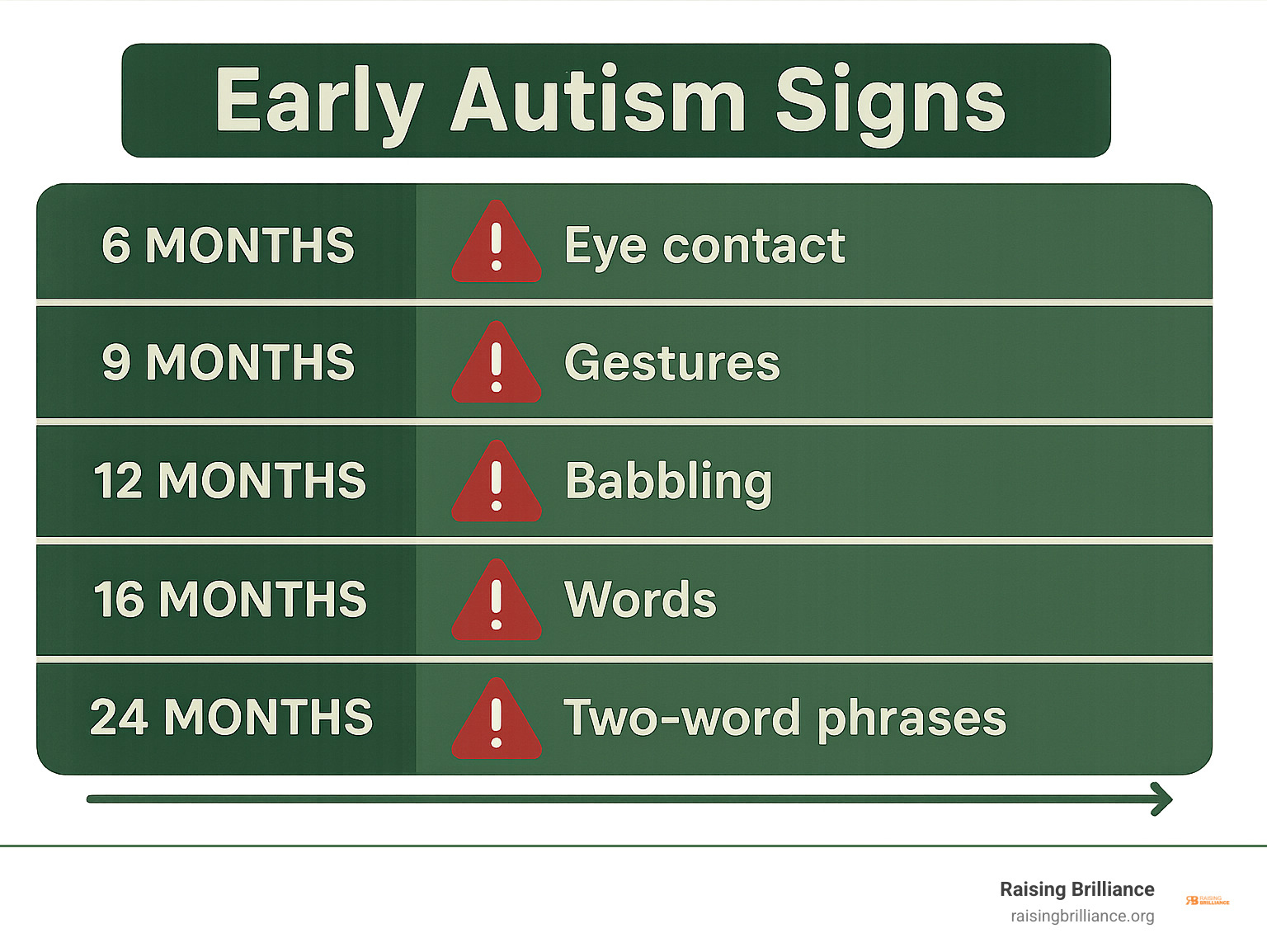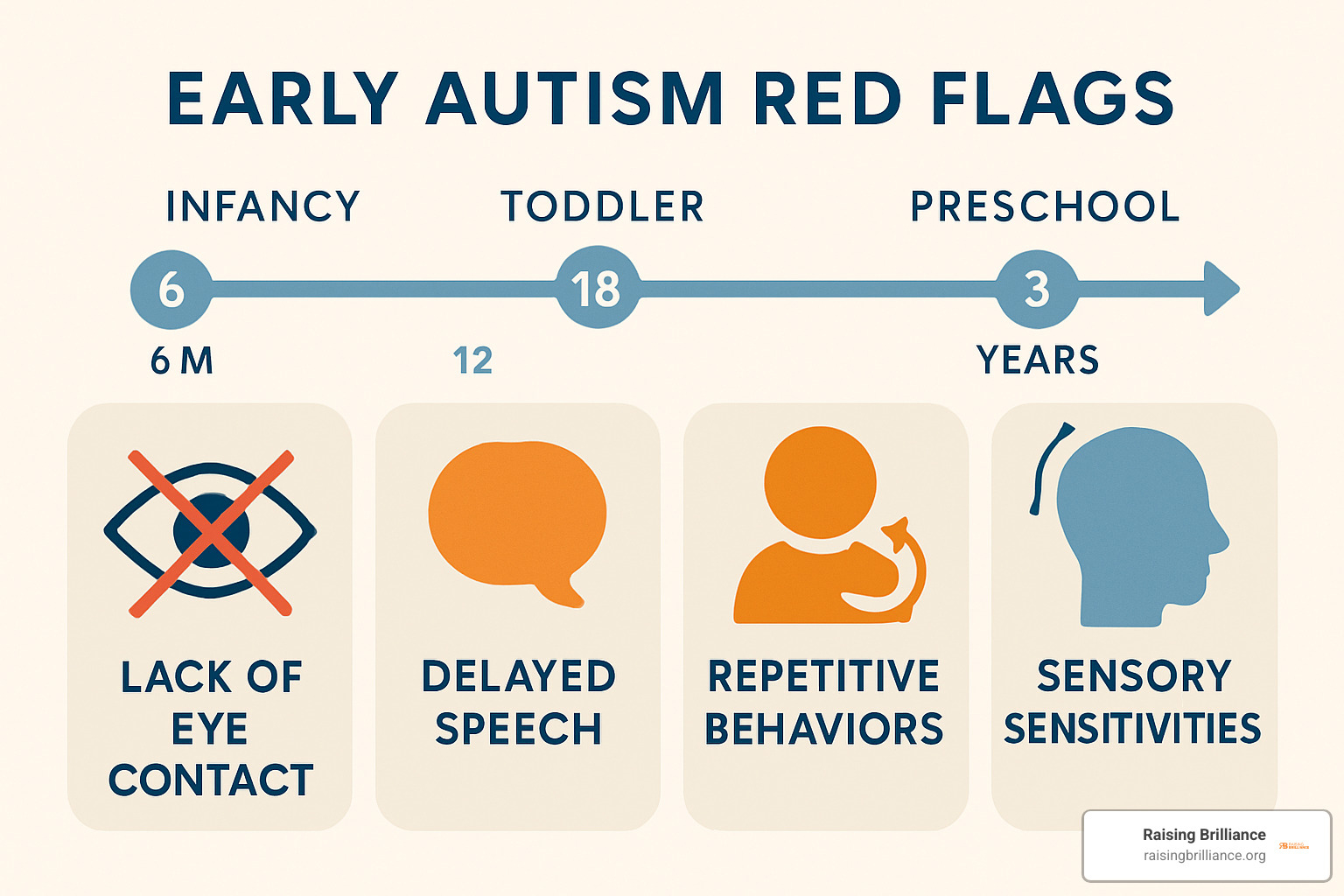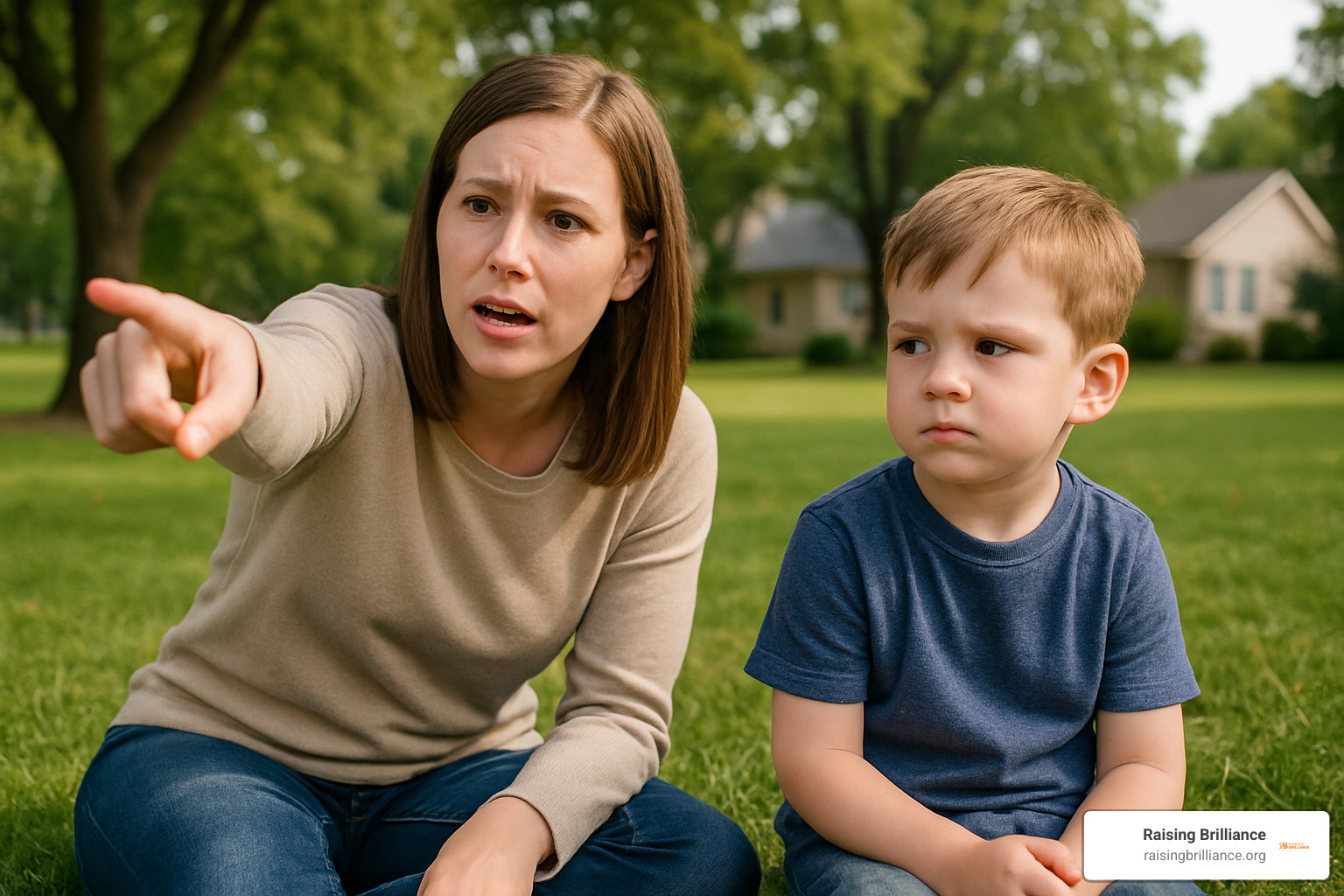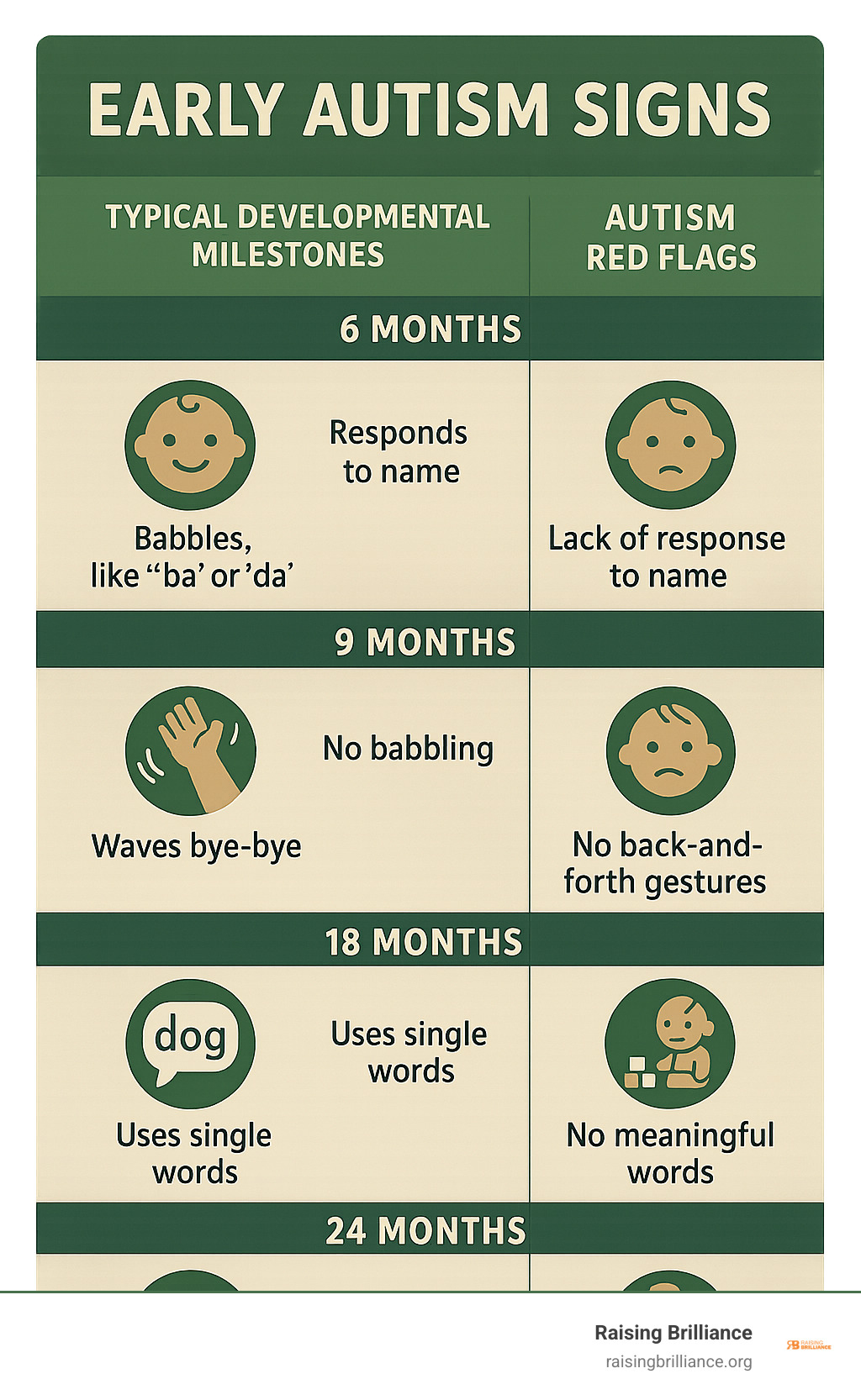- Raising Brilliance
- Posts
- Ultimate Checklist for Early Autism Signs in Children
Ultimate Checklist for Early Autism Signs in Children
Discover early autism signs with our age-based checklist. Learn milestones, red flags, and when to seek help for your child.
Why Recognizing Early Autism Signs Can Change Your Child's Future

Early autism signs typically appear within the first 1-2 years of life, and recognizing them early can dramatically improve your child's outcomes through timely intervention and support.
Most Common Early Autism Signs by Age:
By 6 months: Few or no big smiles, limited eye contact
By 9 months: Little back-and-forth sharing of sounds or expressions, not responding to name
By 12 months: No babbling, pointing, or gestures like waving bye-bye
By 16 months: Very few or no words
By 24 months: Very few or no meaningful two-word phrases
As one mother named Eileen found, using screening tools like the M-CHAT-R helped her secure an early autism diagnosis for her son Charlie - opening doors to crucial early intervention services.
Your parental instincts matter. Research shows that 80-90% of parents notice developmental differences by their child's second birthday. The American Academy of Pediatrics now recommends autism screening at 18 and 24 months because early identification leads to better long-term outcomes.

What Is Autism Spectrum Disorder?
Autism spectrum disorder (ASD) is a developmental condition that affects how a person communicates, interacts socially, and experiences the world around them. The "spectrum" concept recognizes every autistic person as unique - some may need significant daily support, while others live independently and thrive in their careers.
Think of autism as a different way of being wired rather than something that's "broken." These brain differences create both challenges and remarkable strengths. Many autistic individuals have incredible attention to detail, deep expertise in their interests, and unique perspectives that benefit our communities.
About 1 in 54 children in the United States receives an autism diagnosis, according to recent CDC data. Boys are diagnosed about four times more often than girls, but researchers now believe this gap reflects diagnostic bias rather than true prevalence. Girls often present differently and may "mask" their early autism signs by copying social behaviors they observe.
The DSM-5 criteria brought all autism-related conditions under one umbrella - autism spectrum disorder. Understanding autism through a neurodiversity lens helps us appreciate that different doesn't mean less than.
Scientific research on autism diagnosis continues advancing our understanding of how autism develops and how to provide better support for autistic individuals and their families.
Core Diagnostic Domains
When evaluating whether a child might be autistic, professionals look for patterns in two main areas.
Social communication and interaction differences might show up as difficulty with back-and-forth conversations, challenges reading facial expressions or body language, or trouble forming friendships appropriate for their age. Your toddler might not respond to their name consistently or may seem to look "through" people rather than making eye contact.
Restricted and repetitive behaviors can include hand flapping, lining up toys in precise patterns, or intense fascination with specific topics like trains or dinosaurs. Many autistic children also crave routine and predictability - a sudden change in plans might trigger significant distress.
Sensory processing differences often accompany autism. Your child might cover their ears at the grocery store, refuse certain clothing textures, or conversely, seek out intense sensory experiences like spinning or jumping. These aren't behavioral problems - they're neurological differences in how the brain processes sensory information.
Age-Based Checklist of Early Autism Signs

Every child develops at their own pace, but there are certain milestones that most children reach within predictable timeframes. When it comes to early autism signs, timing matters - and knowing what to look for at each stage can help you spot patterns that might otherwise go unnoticed.
Autism doesn't announce itself with a single dramatic moment. Instead, it reveals itself through a collection of subtle differences that become more apparent over time. By 6 months, most babies are flashing those heart-melting social smiles. By 9 months, they're turning their heads when you call their name. By 12 months, they're pointing at things that catch their eye and waving goodbye.
When these milestones don't happen on schedule - or when a child seems to lose skills they once had - it can be one of the first signs that autism might be part of their story. Around 25% of children with autism experience this kind of regression, typically between 15 and 24 months.
Early Autism Signs in Infants (0-12 Months)
The earliest signs of autism in babies can be so subtle that many parents don't notice them until they look back with hindsight. But researchers have identified some key differences that can appear as early as 2 months, becoming more noticeable as babies approach their first birthday.
By 6 months, you might notice that your baby isn't giving you those big, joyful smiles that make your heart melt. Eye contact during feeding or play might seem limited, and they may not respond when you call their name.
Around 9 months, the back-and-forth dance of early communication might feel one-sided. Typically developing babies at this age are masters of the smile-and-respond game, sharing facial expressions and sounds in delightful exchanges. If these interactions feel missing or muted, it could be an early sign.
By their first birthday, most babies are chatty little beings, babbling away and using gestures like pointing, reaching, and waving goodbye. They love simple games like pat-a-cake and peekaboo. Babies showing early autism signs might play with toys in unusual ways, seem more interested in objects than people, or simply not engage in these early social rituals.
Early Autism Signs in Toddlers (12-24 Months)
The toddler years are when early autism signs often become impossible to ignore. This is the age when we expect to see an explosion of language, social connection, and imaginative play.
By 16 months, most toddlers have a vocabulary of 10 to 20 words and are starting to point at things that interest them. They bring objects to their parents to share their excitement. When these behaviors are missing, it can signal that the foundations of social communication aren't developing as expected.
Around 18 months, pointing becomes even more sophisticated. Toddlers point not just to request things, but to share their interests with others. They look when others point, following that invisible line from finger to object. Pretend play starts blossoming - feeding dolls, talking on toy phones, stirring imaginary soup.
By 24 months, most children are putting two words together in meaningful ways - "more juice," "bye-bye mama," "big truck." They notice when others are upset and might try to comfort them. Children with autism might echo words they've heard without understanding their meaning, or they might lose language skills they once had.
During this period, you might also notice repetitive behaviors becoming more prominent. Some toddlers become fascinated with lining up toys in perfect rows, getting genuinely distressed when someone disrupts their arrangements.
Early Autism Signs Beyond Age Two
While most early autism signs appear by age two, some children don't show clear indicators until later. Sometimes parents notice subtle differences but don't realize their significance until preschool, when social demands increase.
By 36 months, most children are naturally drawn to play with other kids. Children with autism might prefer solitary play or seem oblivious to other children altogether.
Around 48 months, pretend play becomes elaborate and creative. When this type of play is missing or very limited, it can indicate autism, especially when combined with other signs.
Some children seem to develop typically until 18 to 24 months and then hit a plateau or even lose skills they once had. Language might disappear, social engagement might decrease, or new repetitive behaviors might emerge.
Intense, focused interests often become more apparent during the preschool years. Children with autism might develop interests that seem unusual in their intensity or focus - knowing everything about vacuum cleaners, memorizing entire movies, or becoming fascinated with specific patterns.

When it comes to early autism signs, social communication challenges often stand out most clearly to parents and caregivers. These aren't just about talking - they're about the whole dance of back-and-forth interaction that typically develops naturally between children and their loved ones.
Think about how most babies naturally engage with you. They look where you look, smile when you smile, and seem to understand that communication is a two-way street. Children who later receive an autism diagnosis often struggle with these fundamental building blocks of social connection.
Joint attention - the ability to share focus on something interesting with another person - is one of the most reliable early indicators we see. While most toddlers will excitedly point at an airplane and look back at you to share their wonder, children with autism may not make these connections as naturally.
About 25% of children later diagnosed with autism experience regression in their language or social skills, typically between 15 and 24 months. Parents often describe this as their child seeming to "go into their own world" or losing words they previously used regularly.
Joint Attention & Gestures: Why They Matter
Joint attention unfolds in beautiful, predictable stages during your child's first 18 months. Most children naturally develop the ability to look where a parent points and share emotional expressions during activities by their first birthday.
By 15 months, something magical typically happens: children begin pointing to share interest, not just to get something. They'll spot a colorful bird outside and point while looking back at you, essentially saying "Look at that amazing thing!" This back-and-forth sharing of attention forms the foundation for all future social learning.
Following a caregiver's gaze and showing objects to others for attention usually emerge by 18 months. Children with autism often show delays in these joint attention skills, or they may develop them in unusual ways.
Scientific research on joint attention consistently shows that these early social communication skills are among the strongest predictors of later language development and social success.
Language Delays and Regression
Language development typically follows a predictable timeline. First words usually appear by 12-14 months, growing to 10-20 words by 16 months, and expanding to 50+ words with two-word combinations by 24 months.
When we see early autism signs in language development, the patterns often look different from typical delays. Children might have very few or no words by 16 months or no meaningful two-word phrases by 24 months. What's particularly concerning is when children lose language skills they previously had.
Echolalia - repeating phrases exactly as they heard them - is another pattern we often see. A child might perfectly recite entire commercials but struggle to ask for a drink of water. Their speech might have an unusual tone, rhythm, or volume.
The sudden loss of language skills - what we call regression - affects about one-quarter of children later diagnosed with autism and typically occurs between 15-24 months. If your child loses words or social skills they previously had, this warrants immediate professional attention.
Restricted, Repetitive Behaviors & Sensory Sensitivities

When three-year-old Maya lined up her toy cars in perfect rows every morning, her parents initially thought it was adorable. But when she had a complete meltdown because her grandmother moved one car, they realized this behavior might be something more significant.
Restricted and repetitive behaviors are often the most visible early autism signs that parents notice. These behaviors aren't just quirks - they serve important purposes for autistic children, helping them feel safe and regulated in a world that can feel overwhelming and unpredictable.
These patterns typically show up in four main ways: repetitive movements like hand flapping or rocking, insistence on keeping things exactly the same, intense interests in specific topics or objects, and unusual reactions to sensory experiences like sounds, textures, or lights.
Research reveals that up to 90% of autistic individuals experience some form of sensory processing differences, making this a crucial area for early identification.
Understanding Sensory Profiles
Think of your child's nervous system like a volume control that might be stuck on too high or too low. Some children are hypersensitive - their volume is cranked up, making everyday sounds feel like sirens and soft touches feel scratchy. Others are hyposensitive - their volume is turned down, so they need extra input to feel anything at all.
Children who are over-responsive might cover their ears during everyday activities, refuse to wear certain clothes because the fabric feels unbearable, or become completely overwhelmed in busy, bright environments. You might notice them having strong reactions to smells that don't bother anyone else.
On the flip side, children who are under-responsive often become sensory seekers. They might spin until they're dizzy, jump off furniture repeatedly, or crash into walls and furniture. These children sometimes don't respond when you call their name - not because they're ignoring you, but because their brain needs more input to register sounds.
Many children show a mix of both patterns. Your child might hate loud noises but constantly seek deep pressure by squeezing between couch cushions. Toe walking is another common sensory behavior you might notice.
Routines, Rigidity & Meltdowns
For autistic children, routines aren't just helpful - they're often essential for feeling safe and calm. While all children do better with some structure, autistic children may need much more predictability and can become genuinely distressed by changes that seem minor to others.
This might look like insisting on taking the exact same route to the grocery store, needing to carry a specific toy everywhere, or becoming extremely upset when bedtime is even five minutes later than usual. Some children need their toys arranged in particular patterns or require certain rituals before transitions.
These behaviors aren't stubbornness - they're coping strategies. When the world feels unpredictable and overwhelming, having some things stay exactly the same provides crucial emotional regulation.
Visual schedules can be incredibly helpful tools for preparing children for changes. Even simple picture cards showing the day's activities can help reduce anxiety about what comes next.
When these needs aren't met or when unexpected changes happen, meltdowns may occur. These aren't tantrums - they're genuine expressions of overwhelm and distress that deserve our understanding and support.
Monitoring Tools and When to Seek Help
Knowing when and how to seek help for early autism signs can feel overwhelming, but the American Academy of Pediatrics has created clear guidelines to make this process easier for families. These recommendations are based on research showing that early identification leads to better outcomes for children.
Your pediatrician should be conducting general developmental screenings at 9, 18, 24, and 30 months, with autism-specific screenings at 18 and 24 months. If your doctor isn't offering these screenings, don't hesitate to ask for them.
Several free tools can help you track your child's development between appointments. The ASDetect app, developed by researchers at La Trobe University, walks you through interactive activities with your child aged 11-30 months to identify potential concerns. The CDC's Milestone Tracker app lets you check off milestones as your child reaches them.
For children between 16 and 30 months, the M-CHAT-R (Modified Checklist for Autism in Toddlers, Revised) is a 20-question screening tool you can complete online. This is the same tool that helped Eileen recognize her son Charlie's needs and secure his early diagnosis.

Practical Steps for Parents
Start documenting what you're seeing. Keep a simple log of behaviors that concern you - when they happen, how often, and what triggers them. Take short videos of repetitive behaviors, unusual play patterns, or moments when your child doesn't respond to their name. These concrete examples are incredibly helpful for healthcare providers.
When preparing for appointments, complete any screening questionnaires beforehand and bring your documentation. Write down specific examples rather than general concerns. Instead of saying "He doesn't talk much," try "He had five words at 18 months but now only uses two words at 24 months."
Trust your parental instincts - research shows that 80-90% of parents notice developmental differences by their child's second birthday. If you have concerns, don't let anyone dismiss them with "boys develop slower" or "Einstein didn't talk until he was four." While some children do develop at their own pace, it's always better to investigate than to miss opportunities for early support.
If your concerns are brushed off, seek a second opinion. Early intervention services are most effective when started before age three, so "wait and see" is rarely the best approach when it comes to developmental concerns.
Professional Assessment & Diagnosis
A comprehensive autism evaluation involves more than just a quick office visit. You'll typically work with a multidisciplinary team that might include a developmental pediatrician, child psychologist, speech-language pathologist, occupational therapist, and educational specialist.
The assessment process examines cognitive abilities, communication skills, social interaction patterns, behavioral responses, and sensory processing. The team will also review your child's medical history and screen for co-occurring conditions like ADHD, anxiety, or sleep disorders that commonly accompany autism.
Healthcare professionals use the DSM-5 criteria to make an official diagnosis, looking for persistent challenges in social communication and restricted, repetitive behaviors that significantly impact daily functioning. Research shows autism can be reliably diagnosed by age 2 by experienced professionals, though the average age of diagnosis is still around 4 years old.
Getting an early, accurate diagnosis opens doors to crucial early intervention services that can make a tremendous difference in helping your child develop communication skills, manage sensory challenges, and build social connections.
Frequently Asked Questions about Early Autism Signs
What age do early autism signs usually appear?
Early autism signs can show up surprisingly early, often within your child's first year of life. Some of the earliest indicators might catch your attention around 6 months - things like less eye contact during feeding or fewer big, joyful smiles than you'd expect.
Most signs become clearer between 12 and 18 months, when you're naturally looking for those exciting first milestones like pointing, waving, and first words. This is when the absence of these typical behaviors becomes more noticeable.
About 25% of children experience regression between 15-24 months. These children might be babbling, saying words, and engaging socially - then suddenly seem to lose those skills. As a parent, this can be incredibly confusing and heartbreaking.
The good news is that research shows autism can be reliably diagnosed by age 2 by experienced professionals. That's why the American Academy of Pediatrics now recommends specific autism screening at both 18 and 24 months.
Can early autism signs differ between boys and girls?
This is such an important question, and the answer is absolutely yes. The fact that boys receive autism diagnoses about four times more often than girls doesn't necessarily mean autism is four times more common in boys - it might mean we're missing it in girls.
Girls often become skilled at masking their challenges. They might copy other children's social behaviors, making them appear more socially capable than they actually feel inside. When overwhelmed, girls are more likely to withdraw quietly rather than have obvious meltdowns, so their distress flies under the radar.
Girls' special interests might seem more "typical" - horses, princesses, or books - but the intensity is what sets them apart. While other children might enjoy these topics, autistic girls often dive deep with encyclopedic knowledge and difficulty talking about anything else.
Boys with autism tend to show more obvious repetitive behaviors and may have special interests in areas like trains, dinosaurs, or technology that adults quickly recognize as "autism-related." Their social communication challenges often appear more apparent in traditional settings.
This difference in presentation means many girls don't get diagnosed until later, sometimes not until adulthood.
Why is early identification critical for intervention outcomes?
Think of your young child's brain like a garden in its most fertile growing season. The earlier you plant the right seeds and provide proper care, the more beautiful and robust the growth will be. This isn't just a nice metaphor - it's backed by solid neuroscience about brain plasticity.
Early intervention literally changes brain development. When children receive appropriate support during their crucial early years, they make connections and develop skills that become the foundation for everything that follows. We're talking about improvements in communication, social relationships, learning abilities, and daily independence.
Children who start intensive early intervention services consistently show more dramatic progress than those who begin later. It's not that older children can't learn and grow - they absolutely can - but those early years offer a unique window of opportunity.
The ripple effects extend far beyond childhood. Better communication skills lead to stronger relationships. Improved social understanding opens doors to educational opportunities. Reduced challenging behaviors mean more family harmony and community participation.
At Raising Brilliance, we've seen countless families whose lives were transformed simply because they trusted their instincts, sought early evaluation, and connected with the right support services.
Conclusion
Recognizing early autism signs is a powerful first step toward supporting your child. Early identification isn’t about labels—it open ups understanding, services, and strategies that nurture growth.
Key points to remember:
Most early signs appear between 6–24 months. Patterns matter more than any single behavior.
Parental intuition is usually right. If you’re worried, ask for autism-specific screening.
Use free tools like the M-CHAT-R or ASDetect, keep brief notes or videos, and share them with your pediatrician.
Early, accurate diagnosis opens doors to evidence-based intervention when the brain is most adaptable.
At Raising Brilliance, we believe autism is a neurological difference, not a defect. With timely support and unconditional love, autistic children can thrive.
If something feels off, speak with your pediatrician today and request screening if it hasn’t been offered. Acting early protects precious developmental time and ensures your child receives the support they deserve.
Social Communication Red Flags